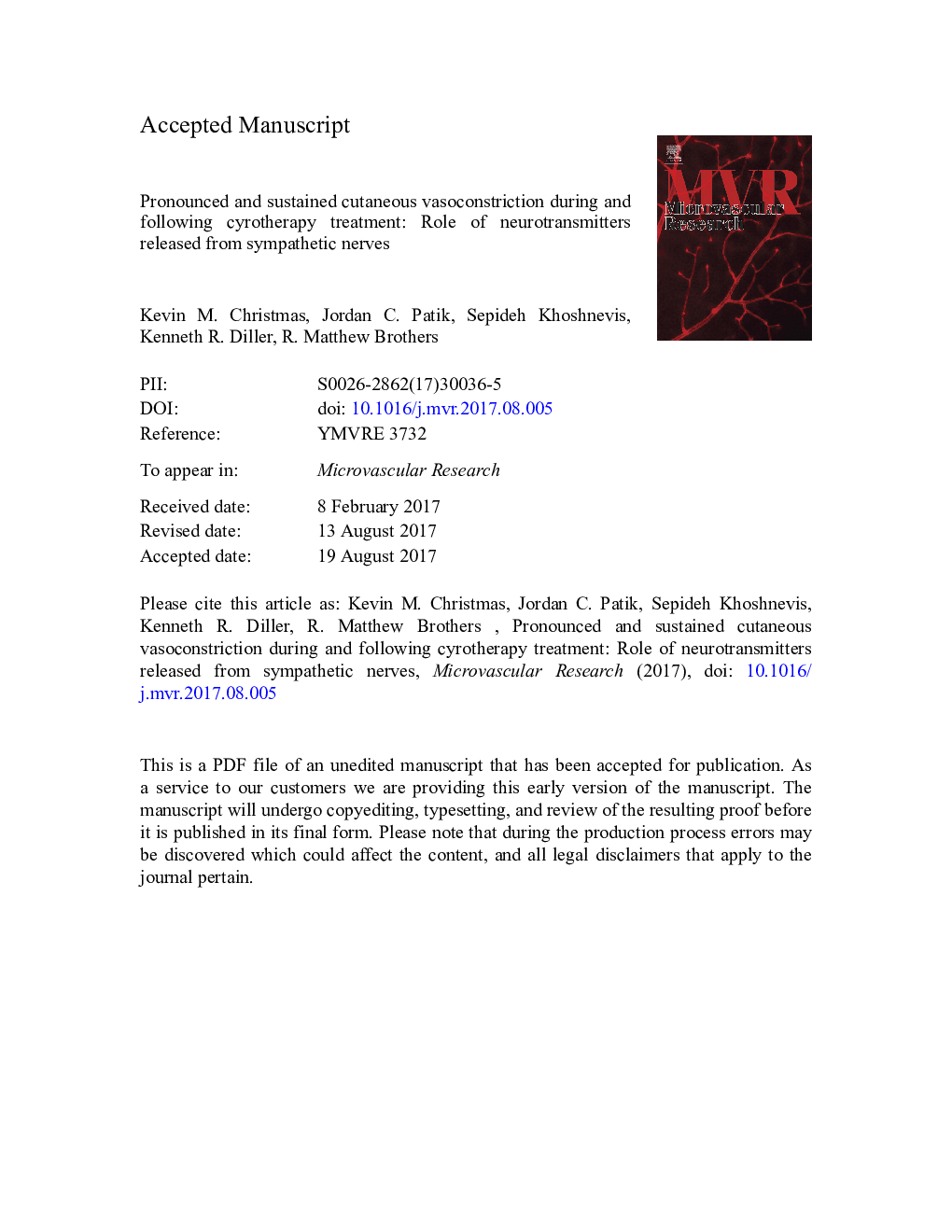| کد مقاله | کد نشریه | سال انتشار | مقاله انگلیسی | نسخه تمام متن |
|---|---|---|---|---|
| 8340968 | 1541269 | 2018 | 27 صفحه PDF | دانلود رایگان |
عنوان انگلیسی مقاله ISI
Pronounced and sustained cutaneous vasoconstriction during and following cyrotherapy treatment: Role of neurotransmitters released from sympathetic nerves
ترجمه فارسی عنوان
واکنش های واژینال پوستی و تحریک شده در طی و بعد از درمان سایروتراپی: نقش انتقال دهنده های عصبی که از عصب سمپاتیک خارج می شود
دانلود مقاله + سفارش ترجمه
دانلود مقاله ISI انگلیسی
رایگان برای ایرانیان
کلمات کلیدی
موضوعات مرتبط
علوم زیستی و بیوفناوری
بیوشیمی، ژنتیک و زیست شناسی مولکولی
زیست شیمی
چکیده انگلیسی
Cryotherapy is a therapeutic technique using ice or cold water applied to the skin to manage soft tissue trauma and injury. While beneficial, there are some potentially detrimental side effects, such as pronounced vasoconstriction and tissue ischemia that are sustained for hours post-treatment. This study tested the hypothesis that this vasoconstriction is mediated by 1) activation of post-synaptic α-adrenergic receptors and/or 2) activation of post-synaptic neuropeptide Y1 (NPY Y1) receptors. 8 subjects were fitted with a commercially available cryotherapy unit with a water perfused bladder on the lateral portion of the right calf. Participants were instrumented with four intradermal microdialysis probes beneath the bladder. The following conditions were applied at the four treatment sites: 1) control (Ringer solution), 2) combined post-synaptic β-adrenergic receptors and neuropeptide (NPY) Y1 receptors blockade (P + B site), 3) combined post-synaptic α-adrenergic receptor, β-adrenergic receptor, and NPY Y1 receptor blockade (Y + P + B site), and 4) blockade of pre-synaptic release of all neurotransmitters from the sympathetic nerves (BT site). Following thermoneutral baseline data collection, 1 °C water was perfused through the bladder for 30 min, followed by passive rewarming for 60 min. Skin temperature (Tskin) fell from ~ 34 °C to ~ 18.5 °C during active cooling across all sites and there was no difference between sites (P > 0.05 vs. control for each site). During passive rewarming Tskin rose to a similar degree in all sites (P > 0.05 relative to the end of cooling). In the first 20 min of cooling %CVC was reduced at all sites however, this response was blunted in the BT and the Y + P + B sites (P > 0.05 for all comparisons). By the end of cooling the degree of vasoconstriction was similar between sites with the exception that the reduction in %CVC in the Y + B + P site was less relative to the reduction in the control site. %CVC was unchanged in any of the sites during passive rewarming such that each remained similar to values obtained at the end of active cooling. These findings indicate that the initial vasoconstriction (i.e. within the 1st 20 min) that occurs during cryotherapy induced local cooling is achieved via activation of post-synaptic α-adrenergic receptors; whereas nonadrenergic mechanisms predominate as the duration of cooling continues. The sustained vasoconstriction that occurs following cessation of the cooling stimulus does not appear to be related to activation of post-synaptic α-adrenergic receptors or NPY Y1 receptor.
ناشر
Database: Elsevier - ScienceDirect (ساینس دایرکت)
Journal: Microvascular Research - Volume 115, January 2018, Pages 52-57
Journal: Microvascular Research - Volume 115, January 2018, Pages 52-57
نویسندگان
Kevin M. Christmas, Jordan C. Patik, Sepideh Khoshnevis, Kenneth R. Diller, R. Matthew Brothers,
